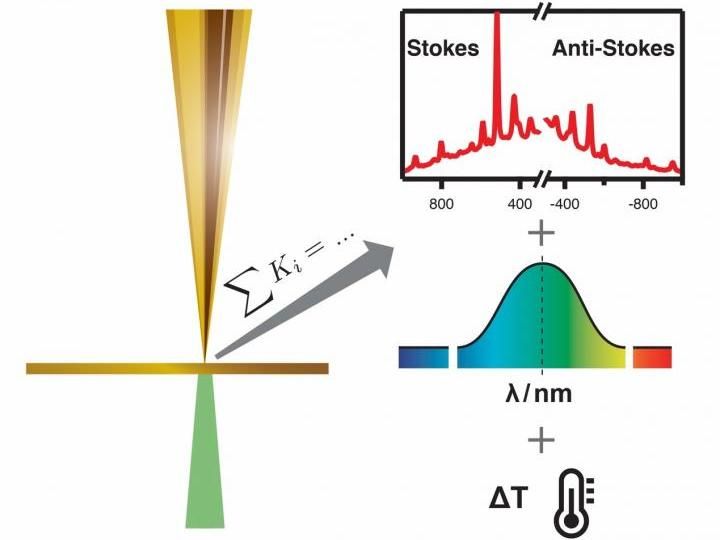Unraveling the optical parameters: New method to optimize plasmon enhanced spectroscopy
Advertisement
For exploring the nanoscale far beyond the optical resolution limit, tip-enhanced Raman spectroscopy (TERS) is widely recognized as an essential yet still emergent technique. Using this marker-free spectroscopic method scientists gain insights into the structural and chemical composition of surfaces with nanoscale resolution, which are not accessible with other methods. Examples where such nanoscale resolution spectroscopies are crucial are structure investigations, of novel materials (e.g. diamond layers, 2D materials etc.), of protein aggregates, discussed as triggers for diseases like diabetes type II or Alzheimer's, or even of catalytical reactions at work. However, scientists' lack of comprehension of crucial parameters of the actual probe still limits the potential of TERS as a user-friendly analytical tool. Until now scientists have not been able to unravel the most fundamentally relevant experimental parameters as the tip's surface plasmon resonance, heating due to near-field temperature rise, and the link towards spatial resolution.

On the left side a schematic view of a tip-enhanced Raman scattering (TERS) experiment is shown. A metallized AFM probe is brought in close proximity to a specimen surface, a laser is focused on the tip-sample interface. Such a setup allows to obtain vibrational spectra (Raman spectra) of an extremely small region, as small as a single molecule or even a single bond. An example of so-called Stokes and Anti-Stokes regions of spectra that are obtained by such an experiment is shown on the upper right column. A thorough assessment of the spectra, as shown by the authors, allows to obtain the structure sensitive Raman spectra and synchronously the specific plasmon resonance properties of the particular tip and the respective temperature. This way tip-induced changes during a measurement are revealed consequently improving the comprehension of the experiment significantly.
by Marie Richard-Lacroix and Volker Deckert
In a new paper in "Light: Science & Application", a research team from Jena, Germany now presents the first accessible method to gain unprecedented insights into the plasmonic activity of a single nanoparticle during a typical TERS experiment. Prof. Volker Deckert from the Leibniz Institute of Photonic Technology, Jena, and Dr. Marie Richard-Lacroix from the Friedrich Schiller University Jena propose a straightforward and purely experimental method to assess the plasmon resonance and near-field temperature experienced exclusively by the molecules directly contributing to the TERS signal. Using standard TERS experimental equipment, the scientists evaluate the detailed near-field optical response, both at the molecular level and as a function of time by probing simultaneously the Stokes and anti-Stokes spectral intensities. This enables them to characterize the optical properties of each individual TERS tip during the measurement.
"The proposed method could be a major step to improve the usability of TERS in day-to-day operation", Prof. Deckert explains. "The actual conditions to which the molecules are submitted from one experiment to the next can now be investigated and optimized directly, in real-time, and at the sample scale." This is especially relevant when it comes to examining biological samples like e.g. proteins which cannot tolerate high temperatures.
"To the best of our knowledge, no other accessible methodology opens up access to such a wealth of information on the plasmonic activity during a typical TERS experiment", Dr. Richard-Lacroix says.
"We believe that this methodology will contribute to improve the accuracy of theoretical models and facilitate any experimental plasmonic investigation and the application of TERS in the field of nanoscale thermometry", the scientists foresee.
Original publication
Other news from the department science
Most read news
More news from our other portals
See the theme worlds for related content
Topic World Spectroscopy
Investigation with spectroscopy gives us unique insights into the composition and structure of materials. From UV-Vis spectroscopy to infrared and Raman spectroscopy to fluorescence and atomic absorption spectroscopy, spectroscopy offers us a wide range of analytical techniques to precisely characterize substances. Immerse yourself in the fascinating world of spectroscopy!

Topic World Spectroscopy
Investigation with spectroscopy gives us unique insights into the composition and structure of materials. From UV-Vis spectroscopy to infrared and Raman spectroscopy to fluorescence and atomic absorption spectroscopy, spectroscopy offers us a wide range of analytical techniques to precisely characterize substances. Immerse yourself in the fascinating world of spectroscopy!

































































